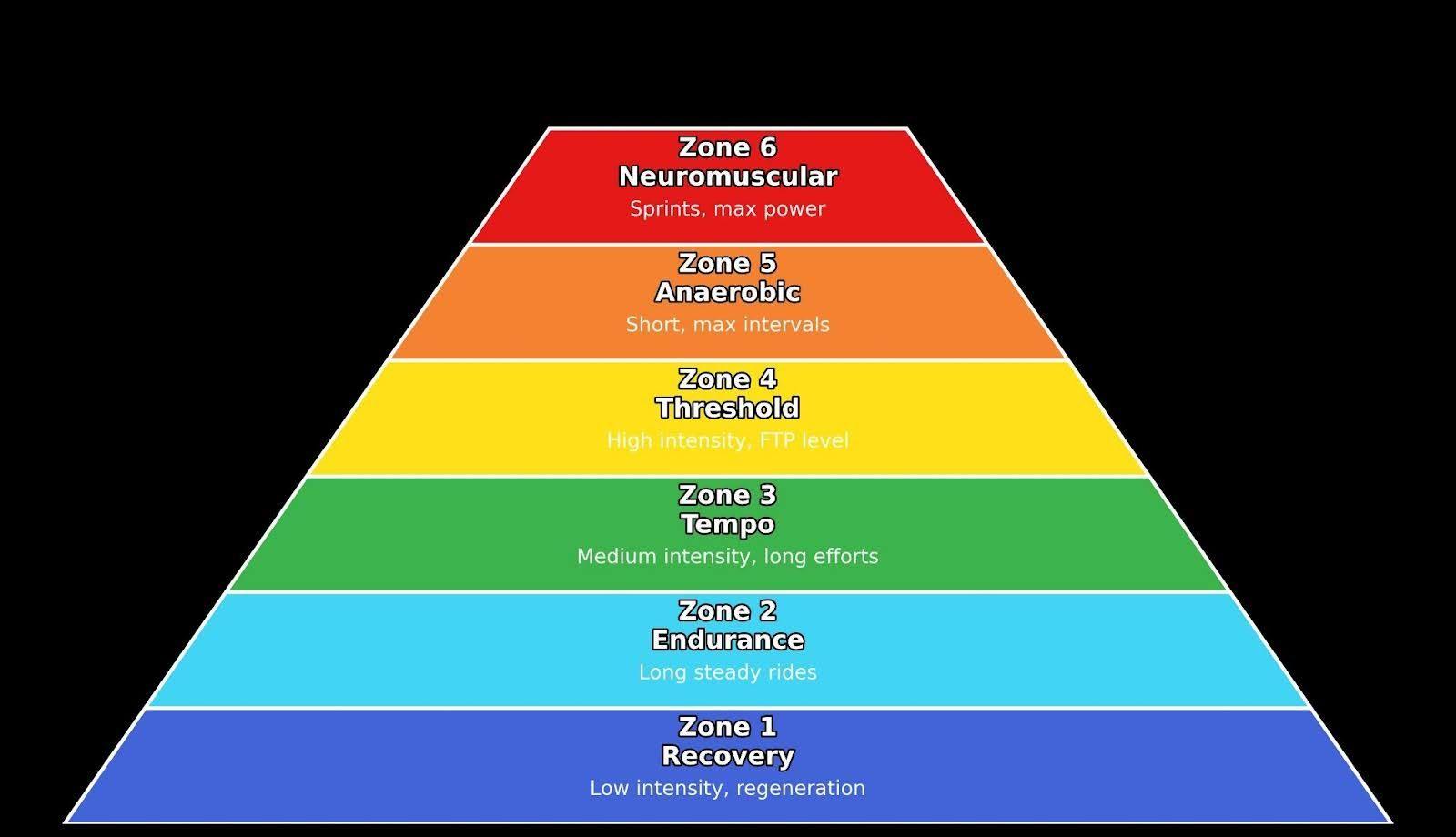
You’ve probably heard about the “training pyramid” – most athletes have. What makes it so valuable is that it provides a clear explanation of the principle that – if you focus too much on high-intensity efforts (training in Zones 3-6) without a solid base of lower-intensity work (Zones 1 and 2) – your fitness pyramid will become unstable.
When that happens, it can take a long time to rebuild. Also, it simply doesn't make sense to build the “top” part of the pyramid without first establishing a solid foundation.
The training pyramid is a simple and effective way to illustrate the importance of a strong endurance base. While it may seem like an old-school approach, it remains a fundamental principle in structured training.
What is Zone 2 training?
Endurance training is the most important part of athletic performance and overall health. Whether you are a cyclist, IRONMAN athlete or runner, understanding how to optimize your aerobic capacity will significantly help your endurance and improve your results.
And Zone 2 training is among the most effective, yet often overlooked, methods for improving endurance.
This guide will explain what Zone 2 training is, its benefits, how to determine your Zone 2 heart rate, and how to effectively integrate it into a training plan.
Typically, that problem is that endurance training requires time, so most people do it during the weekend – if they can make time for it.
Zone 2 training is low-intensity, steady-state (LISS) exercise that focuses on keeping your heart rate within a specific range to maximize aerobic efficiency. It’s typically defined as exercising at 60-70% of your maximum heart rate (HR max). This effort level is moderate enough that you can maintain a conversation while training, but intense enough to stimulate cardiovascular and metabolic adaptations.
How to determine your Zone 2 heart rate
In order to enjoy the full benefits of Zone 2 training, the first step is determining your Zone 2 heart rate. There are a few methods to determine it:
- Heart Rate Calculation Formula (not very accurate). A simple way to estimate your Zone 2 heart rate is by using the following formula:
Maximum Heart Rate (MHR) = 220 - your age Zone 2 Heart Rate = 60-70% of your MHR
For example, if you are 30 years old:
MHR = 220 - 30 = 190 bpm Zone 2 = 60-70% of 190 = 114-133 bpm
- Lactate Threshold Testing (most accurate, but costs some time and money). This is a more precise method involving laboratory or field testing where you measure lactate accumulation. Zone 2 is generally below the point where lactate begins to accumulate rapidly. The lab tests will determine all of your training zones.

- The Talk Test Method (basic). This is a practical method. If you can speak in full sentences during exercise, but feel slightly challenged, you're likely in Zone 2.
Benefits of Zone 2 cardio for cyclists
The advantages of Zone 2 training go far beyond just improving endurance. Here are six reasons why it should be a cornerstone of your cycling training regimen:
Enhanced Aerobic Capacity: By training at low intensities, you develop a stronger aerobic base, allowing your body to become more efficient at using oxygen for fuel. This directly enhances your VO2 Max, the maximum amount of oxygen your body can utilize during exercise.
Increased Mitochondrial Density: Zone 2 training stimulates mitochondrial biogenesis – the production of new mitochondria. More mitochondria means better energy production and improved endurance.
Improved Fat Metabolism: At low intensities, your body prefers fat as a primary energy source, improving metabolic efficiency and prolonging endurance performance.
Reduced Injury Risk: Compared to high-intensity workouts, Zone 2 cardio is gentler on your joints, reducing the likelihood of injuries caused by over training, and allowing for consistent training without excessive fatigue.
Better Recovery and Longevity: Low-intensity training can aid recovery by increasing blood flow and facilitating nutrient delivery to muscles, while also reducing chronic stress associated with high-intensity training.
Support of High-Intensity Performance: A strong aerobic foundation allows you to sustain high-intensity efforts longer before fatigue sets in, making it a crucial component for competitive endurance athletes.
How to implement a Zone 2 cycling training plan
To create and implement a Zone 2 training plan, start by using the formulas or tests above to establish your Zone 2 heart-rate range. Zone 2 training should comprise at least 60-80 percent of your total endurance-training volume.
A well balanced training plan might look like this:
3-4 Sessions Per Week Of Zone 2 Aerobic Training (60-120 minutes per session).
To ensure you stay within Zone 2, use a heart-rate monitor or smartwatch to track your intensity. A heart-rate belt is always the most accurate way to measure this as watches “only” use optical sensors, whereas belts measure via electrocardiogram (ECG).
1-2 Sessions Of Intensity Training (one day with Zone 3 work, and perhaps one day might be even harder and include strength training and flexibility work).
Zone 2 workouts you can try
1. Steady-State Endurance Ride (Cycling) Duration: 90-120 minutes. Intensity: Maintain heart rate within Zone 2. Purpose: Improves aerobic efficiency for long rides.
2. Easy Long Run (Running) Duration: 60-90 minutes. Pace: Comfortable conversation pace. Purpose: Builds endurance while minimizing fatigue.
3. Low-Intensity Swim (Triathlon) Duration: 45-60 minutes. Effort: Easy pace, controlled breathing. Purpose: Enhances aerobic base while reducing joint stress.
4. Rowing or Hiking (Alternative Aerobic Training) Duration: 60-90 minutes. Effort: Steady, controlled breathing.
Purpose: Offers variety while maintaining low-intensity aerobic benefits.










